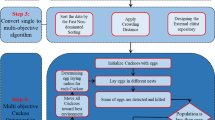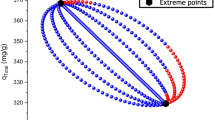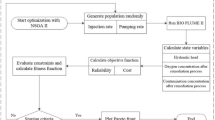Abstract
Sorptive barrier technology is a recently developed tool to separate hazardous contaminants from friendly environment. The design of sorptive barrier refers to configuring different amendments with sorptive ability of organic pollutant, which is an integer programming problem and a relatively time consuming problem as well. In this paper, sorptive barrier design is newly modeled in a biobjective optimization approach, in which the dual problem of sorptive barrier design is deduced. The objectives are to minimize the financial cost and the amount of pollutant leaking through barriers. Then an opposition-based adaptive multiobjective differential evolution algorithm (MODEA-OA) is applied to handle the proposed model. The Pareto optimal front obtained by MODEA-OA spreads accurately and evenly in all three instances tested. To select extreme optimal solutions, the original and dual sorptive barrier design problems can be solved simultaneously. This study suggests that modeling barrier design as a multiobjective optimization problem is an effective approach.





Similar content being viewed by others
References
Wu Z, Chow TWS (2012) A local multiobjective optimization algorithm using neighborhood field. Struct Multidiscip Optim 46(6):853–870
Cai Y, Wang J, Chen Y, Wang T, Tian H, Luo W (2016) Adaptive direction information in differential evolution for numerical optimization. Soft Comput 20(2):465–494
Engelbrecht AP (2016) Particle swarm optimization with crossover: a review and empirical analysis. Artif Intell Rev 45:131–165
Qiao J, Zhang W (2016) Dynamic multi-objective optimization control for wastewater treatment process. Neural Comput Appl. doi:10.1007/s00521-016-2642-8
Piscopo AN, Kasprzyk JR, Neupauer RM (2015) An iterative approach to multi-objective engineering design: optimization of engineered injection and extraction for enhanced groundwater remediation. Environ Modell Softw 69:253–261
Dursun S, Kunt F, Taylan O (2015) Modelling sulphur dioxide levels of Konya city using artificial intelligent related to ozone, nitrogen dioxide and meteorological factors. Int J Environ Sci Technol 12(12):3915–3928
Reed PM, Hadka D, Herman JD, Kasprzyk JR, Kollat JB (2013) Evolutionary multiobjective optimization in water resources the past, present, and future. Adv Water Resour 51:438–456
Endres KL, Mayer A, Hand DW (2015) Equilibrium versus nonequilibrium treatment modeling in the optimal design of pump-and-treat groundwater remediation systems. J Environ Eng 133(8):809–818
Gorelick SM, Zheng C (2015) Global change and the groundwater management challenge. Water Resour Res 51:3031–3051
Mashwani WK, Salhi A (2016) Multiobjective evolutionary algorithm based on multimethod with dynamic resources allocation. Appl Soft Comput 39:292–309
Kamboj VK, Bath SK, Dhillon JS (2016) Multiobjective multiarea unit commitment using hybrid differential evolution algorithm considering import/export and tie-line constraints. Neural Comput Appl. doi:10.1007/s00521-016-2240-9
Mumford KA, Powell SM, Rayner JL, Hince G, Snape I, Stevens GW (2015) Evaluation of a permeable reactive barrier to capture and degrade hydrocarbon contaminants. Environ Sci Pollut Res 22(16):12298–12308
Xu Y, Xu X, Hou H, Zhang J, Zhang D, Qian G (2016) Moisture content-affected electrokinetic remediation of cr(VI)-contaminated clay by a hydrocalumite barrier. Environ Sci Pollut Res 23(7):6517–6523
Matott LS, Bandilla K, Rabideau AJ (2009) Incorporating nonlinear isotherms into robust multilayer sorptive barrier design. Adv Water Resour 32(11):1641–1651
Huang G, Fei L, Yang Y, Wei D, Li S, Huang Y, Kong X (2015) Removal of ammonium-nitrogen from groundwater using a fully passive permeable reactive barrier with oxygen-releasing compound and clinoptilolite. J Environ Manag 154:1–7
Liu N, Ding F, Wang L, Liu P, Yu X, Ye K (2016) Coupling of bio-PRB and enclosed in-well aeration system for remediation of nitrobenzene and aniline in groundwater. Environ Sci Pollut Res 23(10):9972–9983
Ferronato C, Silva B, Costa F, Tavares T (2016) Vermiculite bio-barriers for cu and zn remediation: an eco-friendly approach for freshwater and sediments protection. Int J Environ Sci Technol 13(5):1219–1228
Nicklow J, Reed P, Savic D, Dessalegne T, Harrell L, Chan-Hilton A, Karamouz M, Minsker B, Ostfeld A, Singh A, Zechman E (2010) State of the art for genetic algorithms and beyond in water resources planning and management. J Water Resour Plann Manag 136(4):412–432
Mattot LS, Bartelt-Hunt SL, Rabideau AJ, Fowler KR (2006) Application of heuristic optimization techniques and algorithm tuning to multilayered sorptive barrier design. Environ Sci Technol 40(20):6354–6360
Matott LS, Tolson BA, Asadzadeh M (2012) A benchmarking framework for simulation-based optimization of environmental models. Environ Modell Softw 35:19–30
Nemhauser GL, Laurence WA (1988) Integer and combinatorial optimization. Wiley, New York
Zhang X, Wu Z (2015) Study neighborhood field optimization algorithm on nonlinear sorptive barrier design problems. Neural Comput Appl. doi:10.1007/s00521-015-2106-6
Ali M, Siarry P, Pant M (2012) An efficient differential evolution based algorithm for solving multi-objective optimization problems. Eur J Oper Res 217(2):404–416
Leung SW, Zhang X, Yuen SY (2012) Multiobjective differential evolution algorithm with opposition-based parameter control. In: IEEE congress on evolutionary computation, Brisbane, Australia, pp 2016–2113
Matott LS (2008) Nighthawk documentation and user’s guide, version 1.2, University of Buffalo, Department of Civil, Structure and Environmental Engineering, Buffalo, NY, available online http://www.groundwater.buffalo.edu
Deb K, Pratap A, Agarwal S, Meyarivan T (2002) A fast and elitist multi-objective genetic algorithm: NSGA-II. IEEE Trans Evol Comput 6(2):183–197
Liao TW (2010) Two hybrid differential evolution algorithms for engineering design optimization. Appl Soft Comput 10(4):1188–1199
Zhang X, Fong KF, Yuen SY (2013) A novel artificial bee colony algorithm for hvac optimization problems. HVAC&R Research 19(5):715–731
Deb K, Pratap A, Agarwal S, Meyarivan T (2002) A fast and elitist multiobjective genetic algorithm: NSGA-II. IEEE Trans Evol Comput 6(2):182–197
Acknowledgements
This work described in this paper was supported in part by the National Science Foundation of China (No. 61603275), the Applied Basic Research Program of Tianjin (15JCYBJC52300, 15JCYBJC51500), Scientific Research Fund of Chongqing University (0903005203405, 0215001104469).
Author information
Authors and Affiliations
Corresponding author
Ethics declarations
Conflict of interest
The authors declare that they have no conflict of interest.
Rights and permissions
About this article
Cite this article
Zhang, X., Zhang, X. & Wu, Z. Dual problem of sorptive barrier design with a multiobjective approach. Neural Comput & Applic 30, 2895–2905 (2018). https://doi.org/10.1007/s00521-017-2879-x
Received:
Accepted:
Published:
Issue Date:
DOI: https://doi.org/10.1007/s00521-017-2879-x




